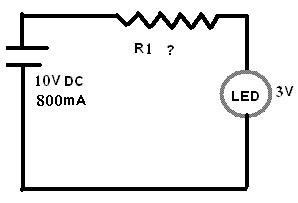jptsunil
Newbie level 2
I am Absolute Begginer in Electronics
Please Help Me ............

Resistor of which value should be place at R1
to achieve 3v and 20mA for LED
and what will be the values of current , volatage and resistance
across each component
I am trying to understand Resistors
since last 15 days but failed badly
Please Explain in Detail
and formula to calculate this problem
i have tried on many website to understand but
- some says resistor resist current
- some says it resist voltage
- some says it resist current and drops voltage
I am in Huge Confussion if any of the above is true
then how its true and how can i calculate it
Please Help Me ............
Resistor of which value should be place at R1
to achieve 3v and 20mA for LED
and what will be the values of current , volatage and resistance
across each component
I am trying to understand Resistors
since last 15 days but failed badly
Please Explain in Detail
and formula to calculate this problem
i have tried on many website to understand but
- some says resistor resist current
- some says it resist voltage
- some says it resist current and drops voltage
I am in Huge Confussion if any of the above is true
then how its true and how can i calculate it